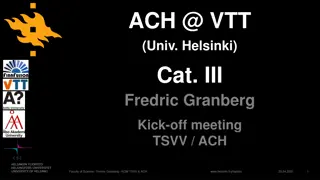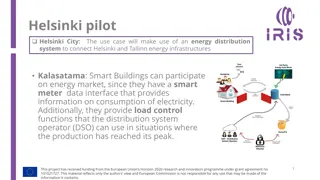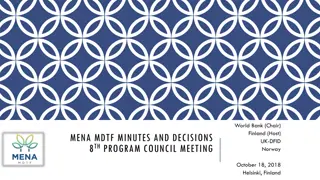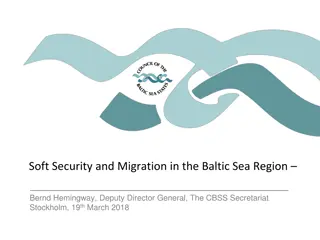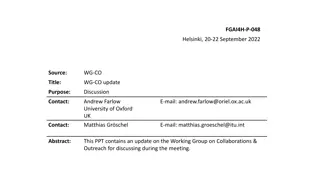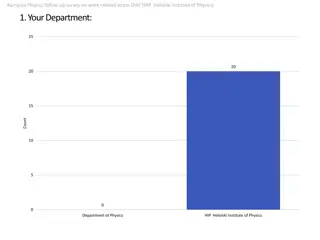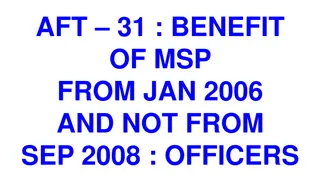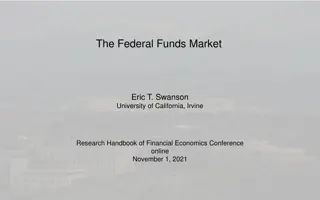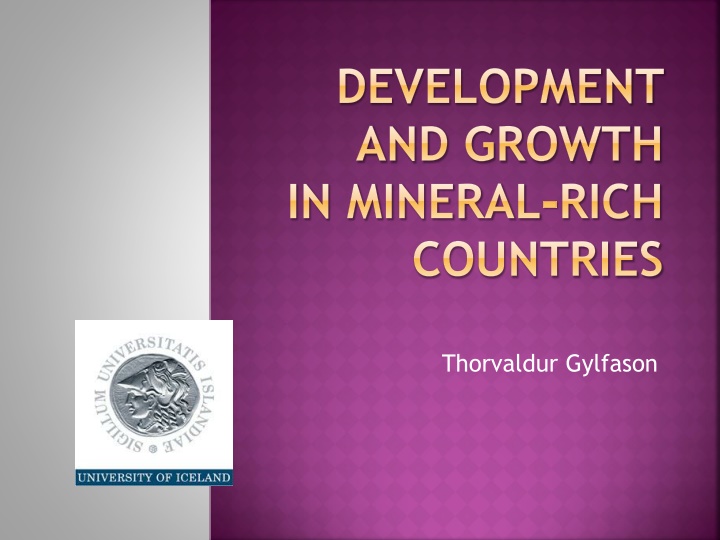
Development and Growth in Mineral-Rich Countries
Explore the relationship between social development and economic growth in mineral-rich countries through cross-country analysis, highlighting the evolving perspectives on natural capital and its impact on national prosperity. Delve into the complexities of resource abundance versus national wealth, drawing insights from key figures such as King Faisal of Saudi Arabia and Lee Kwan Yew of Singapore.
Download Presentation

Please find below an Image/Link to download the presentation.
The content on the website is provided AS IS for your information and personal use only. It may not be sold, licensed, or shared on other websites without obtaining consent from the author. If you encounter any issues during the download, it is possible that the publisher has removed the file from their server.
You are allowed to download the files provided on this website for personal or commercial use, subject to the condition that they are used lawfully. All files are the property of their respective owners.
The content on the website is provided AS IS for your information and personal use only. It may not be sold, licensed, or shared on other websites without obtaining consent from the author.
E N D
Presentation Transcript
DEVELOPMENT AND GROWTH IN MINERAL-RICH COUNTRIES Thorvaldur Gylfason
OUTLINE Social development is integral part of economic development Social content of growth: social policy matters Mineral-rich countries Who they are, how they have done Cross-country patterns in data 164 countries, 1960-2000 New World Bank data on natural capital, including subsoil assets Cross-country regressions How robust is natural capital when aspects of human, social, and real capital are included?
BACKGROUND Old economic geography Assigned key role to natural resource wealth and raw materials Tended to equate those resources with economic and political strength Yet, many resource-abundant countries are quite poor, while several resource-poor countries are very rich President Putin of Russia said it succinctly: Our country is rich, but our people are poor.
BACKGROUND New economic geography Recognizes several different sources of wealth, emphasizing human and also social capital Many resource-rich countries have fared badly, while several resource-poor countries have done well There are several different kinds of capital that grow at different speeds and many different sources of economic growth One kind of capital stands out as, apparently, it tends to get in the way of the others Natural capital
NATURAL CAPITAL: A MIXED BLESSING Listen to King Faisal of Saudi Arabia (1964-1975), as quoted by his Oil Minister, Sheik Yamani: In one generation we went from riding camels to riding Cadillacs. The way we are wasting money, I fear the next generation will be riding camels again. http://www.kff.com/images/fahd.jpg
NATURAL CAPITAL: A MIXED BLESSING Lee Kwan Yew, founding father of Singapore (1959-1991), would not have been surprised either: I thought then that wealth depended mainly on the possession of territory and natural resources, whether fertile land ..., or valuable minerals, or oil and gas. It was only after I had been in office for some years that I recognized ... that the decisive factors were the people, their natural abilities, education and training.
DIFFERENT KINDS OF CAPITAL DRIVE ECONOMIC GROWTH Human capital Education Fertility Social capital Corruption Democracy Inflation Real capital Investment Natural capital Growth
NATURAL CAPITAL AFFECTS OTHER KINDS OF CAPITAL Education Natural capital Investment Corruption Democracy
ECONOMIC GROWTH AND FERTILITY 1960-2000 8 -0.62 Growth of per capita GDP, adjusted for initial 6 4 2 income (% per year) 0 0 1 2 3 4 5 6 7 8 9 10 -2 -4 -6 -8 -10 Fertility (number of births per woman)
ICELANDS PER CAPITA OUTPUT 1901-2006 (2000 = 100) 140 Actual output per capita 120 Korea Potential output per capita 100 80 Botswana 60 Namibia Lesotho 40 Ghana 20 0 1917 1953 1989 1901 1905 1909 1913 1921 1925 1929 1933 1937 1941 1945 1949 1957 1961 1965 1969 1973 1977 1981 1985 1993 1997 2001 2005
SUBSOIL ASSETS (USD AT 2000 PRICES AND EXCHANGE RATES) United States Russian Federation Saudi Arabia Iran, Islamic Republic China Mexico Canada Venezuela, RB United Arab Emirates Kuwait Algeria Nigeria Indonesia Brazil United Kingdom Norway 0 500 1000 1500 2000 Thousands
SUBSOIL ASSETS PER PERSON (USD AT 2000 PRICES AND EXCHANGE RATES) Kuwait United Arab Emirates Saudi Arabia Brunei Oman Bahrain Norway Trinidad and Tobago Gabon Venezuela, RB Canada Turkmenistan Russian Federation Algeria Australia Iran, Islamic Republic Kazakhstan Congo, Republic United States Malaysia Syrian Arab Republic Azerbaijan Mexico Angola Ecuador Chile United Kingdom 0 50 100 150 200 Thousands
EMPIRICAL EVIDENCE IN TWO PARTS First, inspect cross-country patterns in the data through a sequence of bivariate correlations among growth and determinants of growth Let the data do the talking Then, set up a simple multiple regression model where growth depends on the usual suspects plus natural resources Do natural resources help or hurt growth? Are the natural resource variables robust? Do they survive the introduction of other determinants of growth?
EDUCATION AND NATURAL CAPITAL 2000-2005 25 -0.82 20 School life expectancy (years) 15 10 5 0 -0.2 0.0 0.2 0.4 0.6 0.8 1.0 -5 Natural capital as share of total wealth
ECONOMIC GROWTH AND EDUCATION 1960-2000 8 0.69 Growth of per cepita GDP, adjusted for initial 6 4 income (% per year) 2 0 0 5 10 15 20 25 -2 -4 -6 -8 School life expectancy (years)
CORRUPTION AND NATURAL CAPITAL 1960-2000 12 -0.74 10 Corruption perceptions index 8 6 4 2 0 0.0 0.1 0.2 0.3 0.4 0.5 0.6 0.7 0.8 0.9 1.0 Natural capital as share of total wealth
ECONOMIC GROWTH AND CORRUPTION 1960-2000 8 0.75 Growth of per capita GDP, adjusted for initial 6 4 2 income (% per year) 0 0 2 4 6 8 10 12 -2 -4 -6 -8 -10 Corruption perceptions index
DEMOCRACY AND NATURAL CAPITAL 1960-2000 15 -0.67 10 5 Democracy 0 -0.2 0.0 0.2 0.4 0.6 0.8 1.0 -5 -10 -15 Natural capital as share of total wealth
ECONOMIC GROWTH AND DEMOCRACY 1960-2000 8 0.51 Growth of per capita GDP, adjusted for initial 6 4 income (% per year) 2 0 -15 -10 -5 0 5 10 15 -2 -4 -6 -8 -10 Democracy
DEMOCRACY AND EDUCATION 1960- 2000 15 0.62 10 5 Democracy 0 0 5 10 15 20 25 -5 -10 -15 School life expectancy (years)
CORRUPTION AND DEMOCRACY 1960-2000 10 0.60 9 8 Corruption perceptions index 7 6 5 4 3 2 1 0 -15 -10 -5 0 5 10 15 Democracy
ECONOMIC GROWTH AND NATURAL CAPITAL 1960-2000 8 -0.67 Growth of per capita GDP, adjusted for initial 6 4 income (% per year) 2 0 -0.2 0.0 0.2 0.4 0.6 0.8 1.0 -2 -4 -6 -8 -10 Natural capital as share of total wealth
ECONOMIC GROWTH AND SUBSOIL ASSETS 1960-2000 8 -0.10 Growth of per capita GDP, adjusted for initial 6 4 income (% per year) 2 0 -0.5 0 0.5 1 1.5 2 2.5 -2 -4 -6 -8 -10 Subsoil assets as share of total wealth
EMPIRICAL STRATEGY: NEXT STEP Cross-sectional evidence based on 164 countries from 1960 to 2000 Relate per capita economic growth to its main determinants: i.e., measures of the accumulation of different kinds of capital Look for evidence of a linkage between resource dependence, resource abundance, and growth How robust is natural capital? Do the natural capital variables survive the introduction of other determinants of growth? Not trying to demolish other potential explanations of growth Rather, trying to find a complementary role for natural capital: add, not subtract
EMPIRICAL STRATEGY Choices 1) Levels of income vs. rates of growth Makes no difference, get same results either way if income and growth data are consistent Averages vs. initial values of independent variables Prefer averages when available so as not to discard data after the initial period, 1960 Cross sections vs. panels Begin with cross sections, will add panels Recursive modeling vs. instrumental variables Prefer recursive OLS estimation 2) 3) 4)
STRUCTURE OF MODEL Economic growth depends on buildup of capital and efficiency with which it is used Six kinds of capital, of which we include four 1) Natural capital 2) Social capital: democracy 3) Real capital: investment 4) Human capital: education, fertility 5) Financial capital: low inflation -- ignore 6) Foreign capital: openness -- ignore
ABUNDANCE VS. DEPENDENCE Resource poor, resource dependent (Chad, Mali) Resource rich, resource dependent (OPEC) Resource dependence Resource poor, resource free (Jordan, Panama) Resource rich, resource free (Canada, USA) Resource abundance
TABLE 1. REGRESSION RESULTS ON NATURAL CAPITAL AND ECONOMIC GROWTH Model 1 -0.74 (5.2) Initial income Natural capital share Natural capital per person Democracy Investment rate (log) School life expectancy (log) Fertility 164 Countries 0.14 Adjusted R2
TABLE 1. REGRESSION RESULTS ON NATURAL CAPITAL AND ECONOMIC GROWTH Model 1 Model 2 -0.74 (5.2) -0.49 (3.1) -0.04 (5.3) Initial income Natural capital share Natural capital per person Democracy Investment rate (log) School life expectancy (log) Fertility 164 125 Countries 0.14 0.18 Adjusted R2
TABLE 1. REGRESSION RESULTS ON NATURAL CAPITAL AND ECONOMIC GROWTH Model 1 Model 2 Model 3 -0.74 (5.2) -0.49 (3.1) -0.04 (5.3) -0.96 (5.3) -0.06 (7.1) Initial income Natural capital share Natural capital per person Democracy 0.10 (4.5) Investment rate (log) School life expectancy (log) Fertility 164 125 124 Countries 0.14 0.18 0.29 Adjusted R2
TABLE 1. REGRESSION RESULTS ON NATURAL CAPITAL AND ECONOMIC GROWTH Model 1 Model 2 Model 3 Model 4 -0.74 (5.2) -0.49 (3.1) -0.04 (5.3) -0.96 (5.3) -0.06 (7.1) -1.07 (5.2) -0.05 (4.7) Initial income Natural capital share Natural capital per person Democracy 0.10 (4.5) 0.08 (3.7) 0.07 (2.2) Investment rate (log) School life expectancy (log) Fertility 164 125 124 113 Countries 0.14 0.18 0.29 0.27 Adjusted R2
TABLE 1. REGRESSION RESULTS ON NATURAL CAPITAL AND ECONOMIC GROWTH Model 1 Model 2 Model 3 Model 4 Model 5 -0.74 (5.2) -0.49 (3.1) -0.04 (5.3) -0.96 (5.3) -0.06 (7.1) -1.07 (5.2) -0.05 (4.7) -1.24 (7.0) -0.04 (5.3) Initial income Natural capital share Natural capital per person Democracy 0.10 (4.5) 0.08 (3.7) 0.06 (3.3) 0.07 (2.2) 0.07 (2.7) 2.92 (6.8) Investment rate (log) School life expectancy (log) Fertility 164 125 124 113 113 Countries 0.14 0.18 0.29 0.27 0.48 Adjusted R2
TABLE 1. REGRESSION RESULTS ON NATURAL CAPITAL AND ECONOMIC GROWTH Model 1 Model 2 Model 3 Model 4 Model 5 Model 6 -0.74 (5.2) -0.49 (3.1) -0.04 (5.3) -0.96 (5.3) -0.06 (7.1) -1.07 (5.2) -0.05 (4.7) -1.24 (7.0) -0.04 (5.3) -1.72 (10.2) -0.02 (3.2) Initial income Natural capital share Natural capital per person Democracy 0.10 (4.5) 0.08 (3.7) 0.06 (3.3) 0.04 (2.2) 0.07 (2.2) 0.07 (2.7) 2.92 (6.8) 0.08 (3.2) 1.39 (3.0) 3.01 (6.4) Investment rate (log) School life expectancy (log) Fertility 164 125 124 113 113 99 Countries 0.14 0.18 0.29 0.27 0.48 0.61 Adjusted R2
TABLE 1. REGRESSION RESULTS ON NATURAL CAPITAL AND ECONOMIC GROWTH Model 1 Model 2 Model 3 Model 4 Model 5 Model 6 Model 7 -0.74 (5.2) -0.49 (3.1) -0.04 (5.3) -0.96 (5.3) -0.06 (7.1) -1.07 (5.2) -0.05 (4.7) -1.24 (7.0) -0.04 (5.3) -1.72 (10.2) -0.02 (3.2) -1.87 (10.7) -0.02 (2.9) Initial income Natural capital share Natural capital per person Democracy 0.10 (4.5) 0.08 (3.7) 0.06 (3.3) 0.04 (2.2) 0.04 (2.4) 0.07 (2.2) 0.07 (2.7) 2.92 (6.8) 0.08 (3.2) 1.39 (3.0) 3.01 (6.4) 0.06 (2.4) 0.94 (1.9) 2.47 (4.9) Investment rate (log) School life expectancy (log) Fertility -0.31 (2.5) 99 164 125 124 113 113 99 Countries 0.14 0.18 0.29 0.27 0.48 0.61 0.64 Adjusted R2
TABLE 1. REGRESSION RESULTS ON NATURAL CAPITAL AND ECONOMIC GROWTH Model 1 Model 2 Model 3 Model 4 Model 5 Model 6 Model 7 -0.74 (5.2) -0.49 (3.1) -0.04 (5.3) -0.96 (5.3) -0.06 (7.1) -1.07 (5.2) -0.05 (4.7) -1.24 (7.0) -0.04 (5.3) -1.72 (10.2) -0.02 (3.2) -1.87 (10.7) -0.02 (2.9) Initial income Natural capital share Natural capital per person Democracy 0.10 (4.5) 0.08 (3.7) 0.06 (3.3) 0.04 (2.2) 0.04 (2.4) 0.07 (2.2) 0.07 (2.7) 2.92 (6.8) 0.08 (3.2) 1.39 (3.0) 3.01 (6.4) 0.06 (2.4) 0.94 (1.9) 2.47 (4.9) Investment rate (log) School life expectancy (log) Fertility -0.31 (2.5) 99 164 125 124 113 113 99 Countries 0.14 0.18 0.29 0.27 0.48 0.61 0.64 Adjusted R2
TABLE 1. REGRESSION RESULTS ON NATURAL CAPITAL AND ECONOMIC GROWTH Model 1 Model 2 Model 3 Model 4 Model 5 Model 6 Model 7 -0.74 (5.2) -0.49 (3.1) -0.04 (5.3) -0.96 (5.3) -0.06 (7.1) -1.07 (5.2) -0.05 (4.7) -1.24 (7.0) -0.04 (5.3) -1.72 (10.2) -0.02 (3.2) -1.87 (10.7) -0.02 (2.9) Initial income Natural capital share Natural capital per person Democracy 0.10 (4.5) 0.08 (3.7) 0.06 (3.3) 0.04 (2.2) 0.04 (2.4) 0.07 (2.2) 0.07 (2.7) 2.92 (6.8) 0.08 (3.2) 1.39 (3.0) 3.01 (6.4) 0.06 (2.4) 0.94 (1.9) 2.47 (4.9) Investment rate (log) School life expectancy (log) Fertility -0.31 (2.5) 99 164 125 124 113 113 99 Countries 0.14 0.18 0.29 0.27 0.48 0.61 0.64 Adjusted R2
DECOMPOSITION OF GROWTH (IN PERCENT) Standard deviation Per capita growth Variable Per capita growth Natural capital share Democracy Investment (log) School life expectancy (log) Fertility 0.99 0.17 0.15 0.10 0.34 0.22 19.0 6.4 0.29 0.35 1.8 ! Note: The table shows the contributions to per capita growth per year of a decrease in the natural capital share and fertility and an increase in democracy, investment, and school life expectancy by one standard deviation each variable
BUT NORWAY IS DIFFERENT Problem is not the existence of natural wealth Rather, it is the failure to avert the dangers that accompany the gifts of nature Norway is, so far, a success story Government absorbs 80% of oil rent and invests it mostly in foreign securities No signs of damage to growth potential, at least not yet The purpose of the oil fund Share the wealth fairly: Pension fund Shield domestic economy from overheating and waste Fund is huge: USD 300 billion (USD 65K per person) Norwegians have resisted the temptation to use too much of the money to meet current needs
WHY NORWAY SUCCEEDED WHERE MANY OTHERS FAILED Long tradition of democracy and market economy in Norway since before the advent of oil Large-scale rent seeking was averted as oil was defined as a common-property resource from the beginning Adequate investment performance Excellent education record College enrolment rose from 26% in 1980 to 80% in 2004 Even so, Norway faces challenges Some (weak) signs of Dutch disease Stagnant exports, sluggish FDI Limited interest in joining EU and EMU Sluggish reform (e.g., health care provision) Management of oil fund transferred from Ministry of Finance to Central Bank 1999
CONCLUSION Diversification is good for growth Economic diversification away from excessive reliance on natural resources, including minerals Political diversification away from narrowly based political elites toward full-fledged democracy Social and human capital are good for growth Social policies make a difference, including social insurance as well as education and health care Judicious use of natural resources requires good institutions, including democracy Norway leads the way Need to develop strategy to turn natural capital sustainably into human and social capital European solution: Pooling coal and steel worked well Pooling fish through the EU s CFP has worked less well


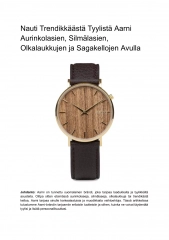
![READ⚡[PDF]✔ Space Exploration 2008 (Springer Praxis Books)](/thumb/21608/read-pdf-space-exploration-2008-springer-praxis-books.jpg)


